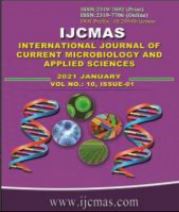


 National Academy of Agricultural Sciences (NAAS)
National Academy of Agricultural Sciences (NAAS)

|
PRINT ISSN : 2319-7692
Online ISSN : 2319-7706 Issues : 12 per year Publisher : Excellent Publishers Email : editorijcmas@gmail.com / submit@ijcmas.com Editor-in-chief: Dr.M.Prakash Index Copernicus ICV 2018: 95.39 NAAS RATING 2020: 5.38 |
The present experiment was laid out in randomised block design with factorial concept having twelve treatment combinations comprising first factor with four levels of land configuration methods viz., L1 - ridge and furrow (45 cm x 30 cm), L2 - raised bed (45 cm x 30 cm), L3 - flat bed (45 cm x 30 cm) and L4 - flat bed (30 cm x 30 cm) while the second factor consisted of three levels of fertilizer viz., N1 -100% fertilizer dose (150:75:100 kg NPK/ha), N2 - 90% FD (135:67.5:90 kg NPK/ha) and N3 - 80% FD (20:60:80 kg NPK/ha) replicated thrice. Among various combinations, raised bed method along with application of 100% FD i.e. 150:75:100 kg NPK/ha (L2N1) recorded significantly maximum number of branches per plant and flower stems per plant. Whereas, flat bed method along with the application of 100% FD i.e. 150:75:100 kg NPK/ha (L4N1) produced maximum flower stems per plot and per ha. As far as economics is concerned, chrysanthemum plants grown on raised bed method along with the application of 100% FD i.e. 150:75:100 kg NPK/ha (L2N1) recorded maximum BCR (0.92).
 |
 |
 |
 |
 |